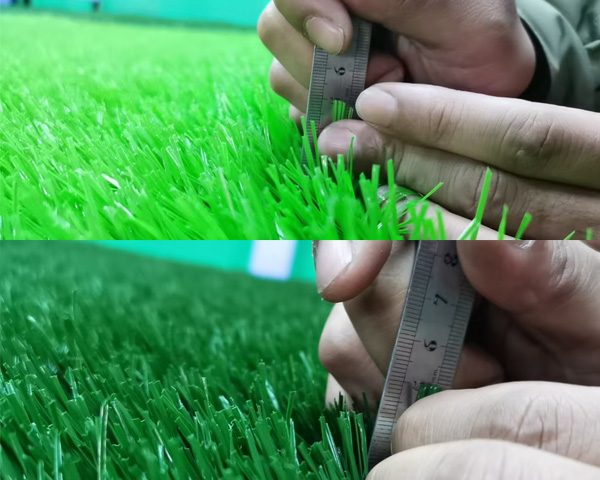
Detailed Analysis of Pile Height, Density, and Weight in Artificial Turf
When selecting and using artificial turf, pile height, density, and weight are the critical parameters that determine product quality, performance, and application scenarios. Below is a detailed breakdown of these three metrics:
![artificial turf]()
I. Pile Height
1. Definition
Pile height refers to the length of the grass fiber from the backing to the tip, typically measured in millimeters (mm).
2. Common Ranges
Pile height generally ranges from 10mm to 60mm, depending on the intended use:
10-20mm: Suitable for indoor decoration, rooftop gardens, and areas requiring low maintenance and durability.
20-35mm: Ideal for leisure areas, children’s playgrounds, and small landscape projects, providing a balance of softness and aesthetics.
35-60mm: Commonly used for sports fields (e.g., football pitches, golf courses), offering better cushioning.
3. Influencing Factors
Visual Effect: Longer pile height looks more natural but is prone to flattening.
Texture and Practicality: Shorter pile height ensures firmness, suitable for high-traffic areas.
II. Density
1. Definition
Density refers to the number of tufted fibers per square meter, typically measured by the number of stitches or tufts.
2. Common Ranges
Low Density (15,000-20,000 tufts/m²): Used in cost-sensitive applications like general leisure areas.
Medium Density (20,000-30,000 tufts/m²): Suitable for school playgrounds, small sports fields, or public greenery.
High Density (30,000 tufts/m² and above): Primarily for professional sports fields requiring high performance.
3. Influencing Factors
Durability: Higher density improves wear resistance and longevity.
Shock Absorption: High-density turf offers better impact absorption, ideal for sports fields.
Cost: Higher density means more materials, leading to increased costs.
III. Weight (Face Weight & Total Weight)
1. Definition
Face Weight: Refers to the weight of the grass fibers alone, usually measured in ounces per square yard (oz/yd⊃2;), indicating durability and texture.
Total Weight: Includes the weight of grass fibers and backing, often measured in grams per square meter (g/m²) or ounces per square yard (oz/yd⊃2;).
2. Common Ranges
Face Weight: Typically ranges from 30-90 oz/yd⊃2;. Recreational applications require 30-50 oz/yd⊃2;, while professional sports fields demand 50-80 oz/yd⊃2;.
Total Weight: Generally ranges from 1,200-2,500 g/m²; heavier turf is more durable.
3. Influencing Factors
Durability: Higher face weight indicates denser fibers and better wear resistance.
Texture: Heavier turf provides a softer feel and better user experience.
Installation and Transport Costs: Heavier turf increases transport and installation expenses.
IV. Interrelationship Between the Three Parameters
1. Pile Height and Density
Higher pile height often requires lower density to prevent excessive weight or flattening. Conversely, shorter pile height can support higher density for enhanced durability and uniformity.
2. Density and Weight
Density directly influences weight; higher density means more fibers and greater weight, offering improved performance but higher costs.
3. Pile Height and Weight
Higher pile height generally results in increased face weight to ensure elasticity and uprightness, which also raises total weight.
V. Recommendations for Selection
1. Choose Pile Height Based on Application
- For residential yards or decoration: 20-30mm.
- For children’s playgrounds: 30-40mm.
- For professional sports fields: 35-60mm, adjusted based on specific sports requirements.
2. Select Density Based on Budget and Usage
- High-traffic areas like school fields: Choose turf with over 20,000 tufts/m².
- For limited budgets, opt for medium-density turf for a balance between cost and performance.
3. Pay Attention to Weight Metrics
- Face weight affects the turf’s feel and durability; ensure it meets your needs.
- Total weight impacts installation and longevity; consider overall requirements.
| Parameter | Definition | Common Range | Application Scenarios |
| Pile Height | Length of grass fibers from the backing to the tip (unit: mm). | 10-60mm | 10-20mm: Decoration, rooftop gardens; 20-35mm: Leisure, playgrounds; 35-60mm: Sports fields. |
| Density | Number of tufts per square meter (unit: tufts/m²). | 15,000-30,000+ tufts/m² | Low density: Decoration; Medium density:School fields; High density: Professional sports fields. |
| Weight | Weight of grass fibers or total material, typically in g/m² or oz/yd⊃2;. | Face weight: 30-90 oz/yd⊃2;; Total weight: 1,200-2,500 g/m² | High face weight: More durable; High total weight: More robust and stable installation. |
VI. Conclusion
Pile height, density, and weight are the core performance indicators for artificial turf. These parameters work together to determine the turf’s application, durability, and user experience. When selecting turf, balance your application needs and budget to ensure you choose the most suitable product.









